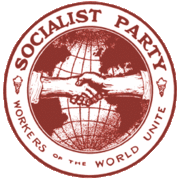
Back الحزب الاشتراكي الأمريكي Arabic Partit Socialista d'Amèrica Catalan Americká socialistická strana Czech Socialist Party of America Danish Sozialistische Partei Amerikas German Socialista Partio de Ameriko Esperanto Partido Socialista de América Spanish حزب سوسیالیست ایالات متحده آمریکا Persian Socialist Party of America Finnish Parti socialiste d'Amérique French
Socialist Party of America | |
|---|---|
 | |
| Founded | July 29, 1901 |
| Dissolved | December 31, 1972 |
| Preceded by | Social Democratic Party of America |
| Succeeded by | Social Democrats, USA (majority; de jure) Socialist Party USA (minority) Democratic Socialist Organizing Committee (minority) |
| Headquarters | Washington, D.C. (minority) |
| Youth wing | Young People's Socialist League |
| Ideology | |
| Political position | Left-wing |
| International affiliation | Second International (1901–1916) Labour and Socialist International (1923–1940) Socialist International (1951–1972) |
| Colors | Red |
| This article is part of a series on |
| Socialism in the United States |
|---|
The Socialist Party of America (SPA) was a socialist political party in the United States formed in 1901 by a merger between the three-year-old Social Democratic Party of America and disaffected elements of the Socialist Labor Party of America who had split from the main organization in 1899.[1]
In the first decades of the 20th century, the SPA drew significant support from many different groups, including trade unionists, progressive social reformers, populist farmers and immigrants. Eugene V. Debs twice won over 900,000 votes in presidential elections (1912 and 1920), while the party also elected two U.S. representatives (Victor L. Berger and Meyer London), dozens of state legislators, more than 100 mayors, and countless lesser officials.[2] The party's staunch opposition to American involvement in World War I, although welcomed by many, also led to prominent defections, official repression, and vigilante persecution. The party was further shattered by a factional war over how to respond to the October Revolution in the Russian Republic in 1917 and the establishment of the Communist International in 1919—many members left the Socialist Party to found Leninist Parties.
After endorsing Robert M. La Follette's presidential campaign in 1924, the party returned to independent action at the presidential level. It had modest growth in the early 1930s behind presidential candidate Norman Thomas. The party's appeal was weakened by the popularity of President Franklin D. Roosevelt's New Deal, the organization and flexibility of the Communist Party under Earl Browder and the resurgent labor movement's desire to support sympathetic Democratic Party politicians. A divisive and ultimately unsuccessful attempt to broaden the party by admitting followers of Leon Trotsky and Jay Lovestone caused the traditional Old Guard to leave and form the Social Democratic Federation. While the party was always strongly anti-fascist as well as anti-Stalinist, its opposition to American entry in World War II cost it both internal and external support.
The party stopped running presidential candidates after 1956, when its nominee, Darlington Hoopes, won fewer than 6,000 votes. In the party's last decades, its members, many of them prominent in the labor, peace, civil rights, and civil liberties movements, fundamentally disagreed about the socialist movement's relationship to the labor movement and the Democratic Party and about how best to advance democracy abroad. In 1970–1973, these strategic differences became so acute that the SPA changed its name to Social Democrats, USA, both because the term "party" in its name had confused the public and to distance itself from the Soviet Union. Leaders of two of its caucuses formed separate socialist organizations, the Socialist Party USA and the Democratic Socialist Organizing Committee, the precursor of the Democratic Socialists of America.
- ^ It was also known as the "Socialist Party of the United States" (as early as the 1910s) and "Socialist Party USA" (as early as 1935, most common in the 1960s), but the organization's official name has always been "Socialist Party of America".
- ^ James Weinstein, The Decline of Socialism in America, 1912-1925, New York: Vintage Books, 1969, pp. 116–118 (Tables 2 and 3).
© MMXXIII Rich X Search. We shall prevail. All rights reserved. Rich X Search